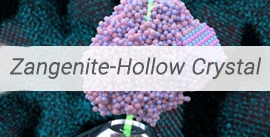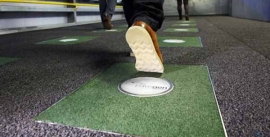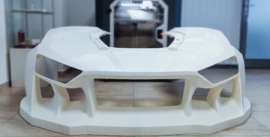 جدید
جدیدروشی جدید برای تشخیص گرافن
دانشمندان یک روش جدید برای تشخیص خواص گرافن بدون استفاده از اتصالات الکتریکی مخرب ، به آنها اجازه بررسی هر دو مقاومت و ظرفیت کوانتومی گرافن و دیگر مواد دوبعدی را می دهد، گسترش دادند
دانشمندان یک روش جدید برای تشخیص خواص گرافن بدون استفاده از اتصالات الکتریکی مخرب ، به آنها اجازه بررسی هر دو مقاومت و ظرفیت کوانتومی گرافن و دیگر مواد دوبعدی را می دهد، گسترش دادند.محققان از موسسه علم نانو سوئیس و دپارتمان فیزیک دانشگاه باسل یافته هایشان را در مجله Physical Review Applied گزارش دادند.
گرافن شامل یک تک لایه از اتم های کربن می باشد.این شفاف،سخت تر از الماس و مستحک تر از فولاد،در عین حال انعطافپذیر،و رسانای الکتریکی بهتر از مس است.
از وقتی که گرافن در سال ۲۰۰۴ برای اولین بار جدا شد،دانشمندان در جهان خواص آن و کاربردهای ممکن برای ماده فوق نازک جستجو کردند.دیگر مواد دو بعدی با زمینه های امیدوارکننده مشابه کاربردی وجود داشت.اگرچه تحقیق کمی در ساختارهای الکترونیک آنها انجام شده است.
بدون نیاز به تماس الکتریکی
اتصالات الکتریکی معمولا به منظور مشخص کردن خواص الکترونیکی گرافن و دیگر مواد دو بعدی استفاده می شود.اگرچه این می تواند خواص مواد را به طور قابل توجهی تغییر دهد.
تیم پروفسور Christian Schönenberger از موسسه علم نانو سوئیس و دپارتمان فیزیک دانشگاه باسل حال یک روش جدید برای بررسی این خواص بدون کاربرد اتصالات توسعه داده اند.
برای این کار، دانشمندان گرافن را در نیترید بور عایق،جاسازی کردند.آن را در یک ابررسانا قرار داده و با یک تشدید کننده ماکروویو متصل کردند. مقاومت الکتریکی و ظرفیت کوانتومی گرافن بر فاکتور کیفیت و تشدید فرکانس اثر می گذارد.اگرچه این سیگنال ها خیلی ضعیف هستند،آنها را می توان با استفاده از ابررسانای تشدید کننده به دام انداخت..
با مقایسه مشخصات ماکروویو تشدید کننده با گرافن در کپسول قرار گرفته و بدون کپسول،دانمشندان میتوانند هر دو مقاومت الکتریکی و ظرفیت کوانتومی را مشخص کنند.
Simon Zihlmann که یک دانشجوی دکترای گروه Schönenberger است توضیح می دهد: این پارامترها در تعیین دقیق خواص گرافن و در شناسایی عوامل محدود کننده برای کاربردشان مهم است.
همچنین مناسب برای مواد دو بعدی دیگر
گرافن در کپسول نیترید بور قرار گرفته به عنوان یک ماده نمونه در طول توسعه روش به کار می رود.گرافن یکپارچه با مواد دیگر با روشی مشابه بررسی شده است.علاوه براین،مواد دو بعدی دیگر نیز می تواند بدون استفاده از اتصالات الکتریکی مشخص شود.برای مثال: نیمه رسانای دی سولفید مولیبدن که در سلول های خورشیدی و نوری کاربرد دارد.
مترجم:مهـرداد خانقلی
New method of characterizing graphene
Scientists have developed a new method of characterizing graphene’s properties without applying disruptive electrical contacts, allowing them to investigate both the resistance and quantum capacitance of graphene and other two-dimensional materials. Researchers from the Swiss Nanoscience Institute and the University of Basel’s Department of Physics reported their findings in the journal Physical Review Applied.
Graphene consists of a single layer of carbon atoms. It is transparent, harder than diamond and stronger than steel, yet flexible, and a significantly better conductor of electricity than copper. Since graphene was first isolated in 2004, scientists across the world have been researching its properties and the possible applications for the ultrathin material. Other two-dimensional materials with similarly promising fields of application also exist; however, little research has been carried out into their electronic structures.
No need for electrical contacts
Electrical contacts are usually used to characterize the electronic properties of graphene and other two-dimensional materials. However, these can significantly alter the materials’ properties. Professor Christian Schönenberger’s team from the Swiss Nanoscience Institute and the University of Basel’s Department of Physics has now developed a new method of investigating these properties without applying contacts.
To do this, the scientists embedded graphene in the isolator boron nitride, placed it on a superconductor and coupled it with a microwave resonator. Both the electrical resistance and the quantum capacitance of the graphene affect the quality factor and resonance frequency of the resonator. Although these signals are very weak, they can be captured using superconducting resonators.
By comparing the microwave characteristics of resonators with and without encapsulated graphene, the scientists can determine both the electrical resistance and quantum capacitance. “These parameters are important in the determination of graphene’s exact properties and in the identification of limiting factors for its application,” explains Simon Zihlmann, a PhD student in Schönenberger’s group.
Also suitable for other two-dimensional materials
The boron nitride-encapsulated graphene served as a prototype material during the method’s development. Graphene integrated into other materials can be investigated in the same way. In addition, other two-dimensional materials can also be characterized without the use of electrical contacts; for example, the semiconductor molybdenum disulfide, which has applications in solar cells and optics.









دیدگاه کاربران